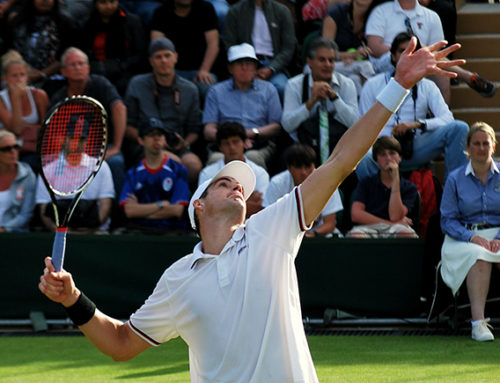You wait patiently, if a little nervously, for your match. There are butterflies in your stomach, but they aren’t too bad. You feel a little jittery – a small electric thrill of anticipation. Eventually the time arrives. It’s match time. Your heart starts pounding in your chest. The butterflies seem to have somehow grown in size, and possible grown claws. Your legs feel heavy, your hands may even be shaking slightly. You look across the net at your opponent, and his game is intimidating. You begin to wonder how you’re going to handle his forehand. The doubts, at first little whispers in the back of your mind become louder, grow stronger. By the time the first point is played, your carefully wrought game-plan seems a paltry thing – by the time a few games have played you’re no longer even thinking about game plans.
Does this story sound familiar? Do you find nerves interfering strongly with your ability to play tennis to the best of your ability? If so, read on to find out exactly what those ‘nerves’ are, and what you can do to combat them.
Humans didn’t always live in cities. We didn’t always get our food from supermarkets, drive on streets patrolled by police cars, as citizens of a country protected by an army. Once we hunted for food. We dealt with predators, both human and otherwise. Our lives were filled with genuine peril, our existence a near daily struggle for survival. In the process we developed a response to times of danger – called “Fight or Flight” – the purpose of which was to enhance our ability to survive.
Fight or Flight is supposed to do exactly what it sounds like. It is a physiological response to a perceived thread that prepares the human body to either fight or flee. The heart-rate becomes accelerated, as does breathing. Digestion slows or stops. Blood rushes to our extremities, paired with the constriction of some blood vessels and the dilation of others. A flood of adrenaline is released into the body. Along with this one might experience tunnel vision and/or impaired hearing. In short the body is primed for immediate, drastic, extreme physical exertion.
Why Are Tennis Matches Threatening?
I’m sure the intelligent readers have put two and two together. The ‘symptoms’ of Fight or Flight are the same as those experienced by a nervous tennis player. But why is that? Why would we experience the physiological response to a perceived mortal danger over a tennis match?
Because as humans, we have a need to categorize things, to identify them. That includes identifying ourselves. We no longer distinguish ourselves as the tribe’s best hunter, or through the mere act of survival. Instead we are identified by society by our roles, our achievements. There is social prestige in being a doctor. We adore our athletes, and teenage girls pass out when meeting their pop star idols. We revere ‘winners’ even if we don’t necessarily like them. So what does that mean about ‘losers’? Their prestige drops. Their role is lessened. We have replaced tigers and poisonous snakes with loss of social prestige and damage to self image.
Why Does It Impact Some People So Negatively?
Not everyone responds to Fight or Flight responses the some way. The severity of the response varies from person to person, and we all process and react to it differently both physically and psychologically. To some, the response is simply fuel to the fire – they harness it to drive them to better performance. But here’s a quick break-down on what happens to those to whom the response isn’t as positive.
As mentioned above, Fight or Flight is the body preparing for immediate, drastic physical action. Some aspects of this preparation in fact require us to engage in such physical activity in order to avoid negative effects. The adrenaline release, for example, is something that demands a level of activity, and if it is not harnessed and used, it makes us jittery and anxious. Likewise the blood rushing to the extremities, if not used, makes our legs feel heavy and slow. The blood leaving the brain, on the other hand, can impair our judgment and ability to think clearly – often resulting in the player having trouble focusing, and failing to execute their game plan.
What Can We Do?
There are two basic approaches to dealing with Fight or Flight response. The goal is to prevent the adrenaline buildup, the blood redirection etc from reaching their peak. The first method of doing this is to use physical actions and psychological techniques to siphon off some of the adrenaline as it rises, and to keep blood moving the way that it should. The second is to dampen it – to stop the Fight or Flight response from ever rising above an undesirable level. We have a great example of each approach right now at the top of the pro game with two players who have a long established rivalry – Nadal and Federer.
The Siphon Method
In case you hadn’t guessed, Nadal is the one of the pair who uses this technique. Nadal gets nervous like anyone – as former world #1 Lleyton Hewitt said recently “It just shows that you want it.” A lot (perhaps most) people believe that Nadal’s pre-match routine is all about intimidation. The way he dances at the net, staring his opponent down during the coin toss. The sprint back to the baseline to begin the warm-up. The way he hits harder than most anyone during warm-up (for those not in the know, most players warm up at a lower pace than they play the match).
Look at it from a different perspective. A nervous Nadal dances around at the net to keep the blood flowing around his body and prevent it from pooling in his extremities. He sprints back to the baseline to use up some of the adrenaline coursing through his veins. He brings the heat in warm-up to prevent himself slowing down and falling into a state of nervous anxiety. Nadal is a poster-boy for handling his pre-match nerves through the ‘get it out’ method.
So what can you learn from him? Staring opponents down may not make you popular at your local club. But you can take some of his cues and substitute to avoid offending anyone. Find some physical activity to partake in right before your match. Jump rope, do a handful of air squats. When you feel the nerves start to rise, do something physical to head it off and siphon away some of the nervous energy. Along with that, bring an aggressive mentality. This doesn’t mean you have to play attacking tennis, or hit the snot out of the ball during the warm-up. But you can still put your head into an aggressive mind-set. Imagine yourself as predator, not prey.
The Dampening Approach
The second option is to prevent things from going ‘too far’. We look at Federer, calm and collected before the match. In comparison to Nadal, Federer looks positively meditative. Instead of letting the Fight or Flight response rise and siphoning off the energy to prevent overload, Federer stops it from ever getting out of control. As it turns out, many of the systems in the human body are intricately interlinked. We can use some of this knowledge to control our physiological responses, even indirectly. For example, you cannot will your heart-beat to slow down. But you can control your breathing, and your breathing affects your heart-rate. Don’t believe it? Try it yourself. Take your pulse right now without breathing in any particular way. Then take deep, long, slow breaths and take your pulse again. You can feel its impact in the moment.
Controlling breathing is one great way to slow down and minimize the Fight or Flight response. Ever see someone get so nervous they had a panic attack? Symptoms include hyper ventilating and having trouble breathing. By taking longer, slower breaths when you start to feel nervous, you keep your heart rate from rising too quickly, which also stops adrenaline from flooding through your body.
Calming mental imagery, and calming music are two other ways to keep the body’s response under control. Picturing yourself on a beach somewhere, the waves crashing gently onto the sand as the warm breeze flows by affects your physical state. The idea is to affect your mental state in such a way as to reduce the perceived threat to self.
Conclusion
Almost everyone gets nervous. Whether you are a top level professional or a low-level club player, nerves can play a role. Overcoming them is possible, but it takes work and practice. You cannot read this article and think that all of your problems are solved. You have to choose an approach and try it. And then try to improve it. Every person is different, and it is important that you find a method of dealing with your nerves that works for you. But understand that the goal is not to eliminate nerves, but rather to harness and deal with them.


